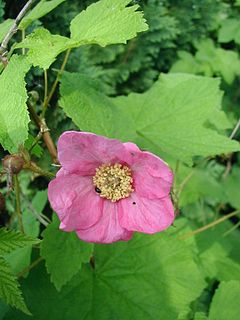
Rubus is a large and diverse genus of flowering plants in the rose family, Rosaceae, subfamily Rosoideae, with over 1,350 species.

The blackberry is an edible fruit produced by many species in the genus Rubus in the family Rosaceae, hybrids among these species within the subgenus Rubus, and hybrids between the subgenera Rubus and Idaeobatus. The taxonomy of blackberries has historically been confused because of hybridization and apomixis, so that species have often been grouped together and called species aggregates. For example, the entire subgenus Rubus has been called the Rubus fruticosus aggregate, although the species R. fruticosus is considered a synonym of R. plicatus.

The dewberries are a group of species in the genus Rubus, section Rubus, closely related to the blackberries. They are small trailing brambles with aggregate fruits, reminiscent of the raspberry, but are usually purple to black instead of red. Alternatively, they are sometimes referred to as ground berries.

Rubus chamaemorus is a species of flowering plant in the rose family Rosaceae, native to cool temperate regions, alpine and arctic tundra and boreal forest. This herbaceous perennial produces amber-colored edible fruit similar to the blackberry. English common names include cloudberry, nordic berry, bakeapple, knotberry and knoutberry, aqpik or low-bush salmonberry, and averin or evron.

The raspberry is the edible fruit of a multitude of plant species in the genus Rubus of the rose family, most of which are in the subgenus Idaeobatus. The name also applies to these plants themselves. Raspberries are perennial with woody stems. World production of raspberries in 2020 was 895,771 tonnes, led by Russia with 20% of the total.

Rubus idaeus is a red-fruited species of Rubus native to Europe and northern Asia and commonly cultivated in other temperate regions.

Rubus spectabilis, the salmonberry, is a species of bramble in the rose family Rosaceae, native to the west coast of North America from west-central Alaska to California, inland as far as Idaho. Like many other species in the genus Rubus, the salmonberry plant bears edible fruit, typically yellow-orange or red in color, resembling raspberries in appearance.

Rubus occidentalis is a species of Rubus native to eastern North America. Its common name black raspberry is shared with other closely related species. Other names occasionally used include bear's eye blackberry, black cap, black cap raspberry, and scotch cap.

Rubus parviflorus, commonly called thimbleberry, is a species of Rubus native to northern temperate regions of North America. It bears edible red fruit similar in appearance to a raspberry, but shorter, almost hemispherical. Because the fruit does not hold together well, it has not been commercially developed for the retail berry market, but is cultivated for landscapes. The plant has large hairy leaves and no thorns.

Rubus arcticus, the Arctic bramble or Arctic raspberry, is a species of slow-growing bramble belonging to the rose family, found in arctic and alpine regions in the Northern Hemisphere.

Rubus odoratus, the purple-flowered raspberry, flowering raspberry, or Virginia raspberry, is a species of Rubus, native to eastern North America, from Nova Scotia west to Ontario and Wisconsin, and south along the Appalachian Mountains as far as Georgia and Alabama.

Rubus leucodermis, also called whitebark raspberry or blackcap raspberry, is a species of Rubus native to western North America, from Alaska southward along the Pacific coast as far as California, Arizona, New Mexico, and Chihuahua.

Rubus strigosus, the American red raspberry or American raspberry, is a species of Rubus native to much of North America. It has often been treated as a variety or subspecies of the closely related Eurasian Rubus idaeus, but currently is more commonly treated as a distinct species. Many of the commercial raspberry cultivars grown for their fruit derive from hybrids between R. strigosus and R. idaeus; see Raspberry for more details.
Black raspberry is a common name for three species of the genus Rubus:

Rubus laciniatus, the cutleaf evergreen blackberry or evergreen blackberry, is a species of Rubus, native to Eurasia. It is an introduced species in Australia and North America. It has become a weed and invasive species in forested habitats in the United States and Canada, particularly in the Northeast and along the Pacific Coast.

Rubus armeniacus, the Himalayan blackberry or Armenian blackberry, is a species of Rubus in the blackberry group Rubus subgenus Rubus series Discolores Focke. It is native to Armenia and Northern Iran, and widely naturalised elsewhere. Both its scientific name and origin have been the subject of much confusion, with much of the literature referring to it as either Rubus procerus or Rubus discolor, and often mistakenly citing its origin as western European. Flora of North America, published in 2014, considers the taxonomy unsettled, and tentatively uses the older name Rubus bifrons.

Rubus ursinus is a North American species of blackberry or dewberry, known by the common names California blackberry, California dewberry, Douglas berry, Pacific blackberry, Pacific dewberry and trailing blackberry.

Rubus ulmifolius is a species of wild blackberry known by the English common name elmleaf blackberry or thornless blackberry and the Spanish common name zarzamora. It is native to Europe and North Africa, and has also become naturalized in parts of the United States, Australia, and southern South America.

Rubus flagellaris, the northern dewberry, also known as the common dewberry, is a North American species perennial subshrub species of dewberry, in the rose family. This dewberry is distributed across much of Canada, Mexico, and the United States. It grows in diverse habitats ranging from drier savannas to temperate deciduous forests.
Rubus setosus, the bristly blackberry, is a North American species of flowering plant in the rose family. It is widespread in much of central and eastern Canada and the northeastern and north-central United States

















